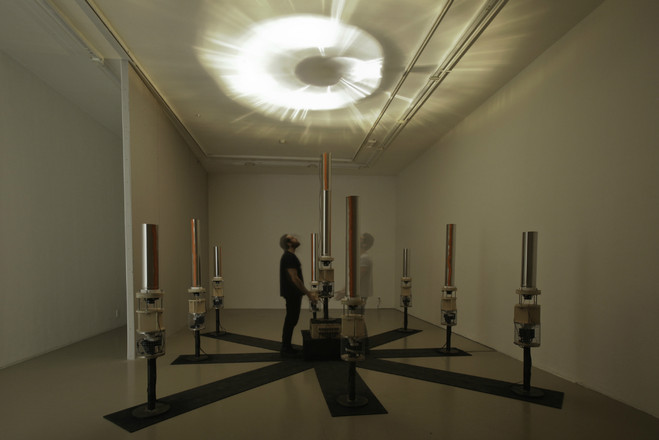It is in a wholly other directed approach that the Institut d’art contemporain opens its doors to two projects: De Mineralis, pierres de visions & Kata Tjuta.
The research subjects introduced here, fundamentally linked to the preoccupations and concerns of the IAC, will be further developed in the context of the Station 10 of the Laboratory space brain in December of 2015.
They build upon the recent attempts to be freed from the terms and conditions of the aesthetic experience in its usual acceptance, so as to privilege the attention, perception and sensations of the visitor (following exhibition The Collection Under Review, Artwork Experiences, 2014).
The Institute, having placed research at the heart of its activities since its creation, presents itself as a place of Otium: an intermediary lapse of time, a time for thought, for mediation, propitious to intuition and awareness.
The gardens, like the interior spaces, will be opened, welcoming these projects developed in an elsewhere, becoming, for a Summer, a here.
The research subjects introduced here, fundamentally linked to the preoccupations and concerns of the IAC, will be further developed in the context of the Station 10 of the Laboratory space brain in December of 2015.
They build upon the recent attempts to be freed from the terms and conditions of the aesthetic experience in its usual acceptance, so as to privilege the attention, perception and sensations of the visitor (following exhibition The Collection Under Review, Artwork Experiences, 2014).
The Institute, having placed research at the heart of its activities since its creation, presents itself as a place of Otium: an intermediary lapse of time, a time for thought, for mediation, propitious to intuition and awareness.
The gardens, like the interior spaces, will be opened, welcoming these projects developed in an elsewhere, becoming, for a Summer, a here.
DE MINERALIS, PIERRES DE VISIONS
MARINA ABRAMOVIĆ, ART ORIENTÉ OBJET, HALLDÓR ÁSGEIRSSON, BASSERODE, CÉCILE BEAU, MICHEL BLAZY, KATINKA BOCK, SOFIA BORGES, CHARLEY CASE, CÉLINE CLÉRON, JASON DODGE, AURÉLIE DUBOIS ARTISTE DE GARDE, JEAN-LUC FAVERO, PAUL-ARMAND GETTE, ERIC & MARC HURTADO, ALEXANDRE JOLY, FRANS KRAJCBERG, GABRIEL LEGER, MYRIAM MECHITA, CAMILLE RENAHRD, JEAN-JACQUES RULLIER, LIONEL SABATTÉ, ELSA SAHAL, VLADIMÍR ŠKODA, TUNGA
In a continuation of the Rêve Caverne exhibition, presented in the Château-musée of Tournon-sur-Rhône, De Mineralis, pierres de visions explores the question of the relationship between the human and the mineral. Humanity and artists have always enjoyed a particular and privileged relationship with the mineral world.Long before cave art, the first lithic industries seemed to have already established an intimate relationship with the spirit of the matter that can be seen more clearly on the surfaces of the ornate palaeolithic caverns.
To better understand these realities, that are not of a symbolic nature, this project considers one of the particularities of the relationship that exists between artists and the mineral: when stone intervenes in their visionary economy. That which can be seen in cave art is equally visible in the work of many contemporary artists.
De Mineralis, pierres de visions wishes to explore and exhibit these strange and ineffable continuities. For the occasion, more than twenty artists have been invited to translate their relationship with stone and the mineral as generators of vision and experimentation of matter.
Cave, rock and stone are dealt with here from an “animistic” point of view, when this material is doted with its own life with which the artists enter into dialogue. This project also proposes to experiment with the visionary capacities that can be developed through contact with certain minerals.
KATA TJUTA
BASSERODE, JIMMIE DURHAM, FRANCESCO GENNARI, ANTHONY MCCALL, MATT MULLICAN, SIGMAR POLKE, DAVID RABINOWITCH, MATTEO RUBBI, VAHAN SOGHOMONIAN (AVEC FABIEN AINARDI, MATTHIEU REYNAUD ET RAPHAËL DE STAËL), JAMES TURRELL
Echoing De Mineralis, pierres de visions, that dotes the mineral with an interiority and a vital force, Kata Tjuta envisages matter- energy as constitutive of a space in tension, vibrating. One’s view is no longer focussed on the materials themselves, with their different characteristics and potentialities, but rather on the energy that they free up, on the telluric spaces that generate another way of seeing the world.Curious in regards to the physical connection between the mineral world and the celestial sphere, between the earth and the cosmos, this project attempts to spatially translate the effects of friction, movement and transformation of matter, such as they may be used as metaphors by artists, being restored through sensitive experiences. A window on the world slips and shifts from the vertical to the horizontal, the ether to the solid, the mass to the scrap, the inanimate to the living.
Between the deserts of Mars and the sacred peaks of Kata Tjuta, the visitor is invited here to traverse a landscape, both enveloping and open, physical and interior: walking, feeling, experiencing, dreaming, becoming one with the space made real.


